If, like me, you’ve heard of Elderflower and you are curious to know what elderflowers taste like and how to use them, you’ve come to the right place. In this article, we explore what elderflowers are, how to identify them as well as the taste and creative ways to use these delicate flowers.
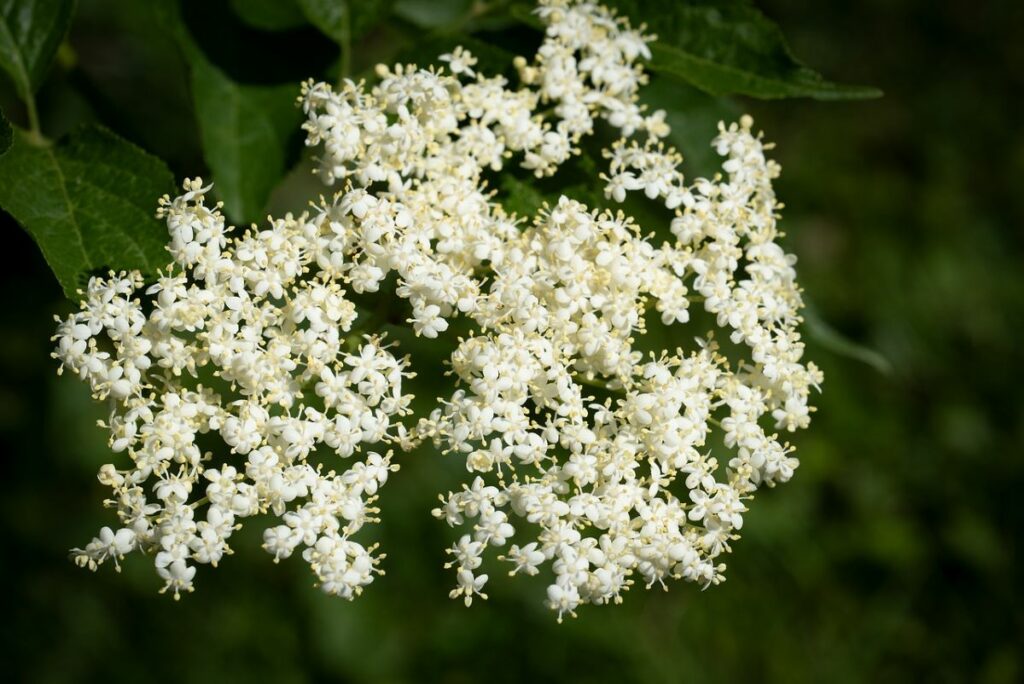
Table of Contents
What is Elderflower?
Elderflower is a small white blossom that grows on the elder tree, known for its delicate floral flavor and beautiful aroma.
You may have seen elderflower used to make drinks such as elderflower cordial, elderflower champagne, or elderflower syrup. These are very popular ways to use elderflower but they can also be used in baking, as a flavoring for desserts, and as a decorative garnish to really make your dish impressive.
As well as its culinary uses, elderflower has been used in traditional medicine for centuries. It’s believed to have anti-inflammatory, antiviral, and antioxidant properties, and it has been used to treat conditions such as colds, flu, and sinus infections.
Elderflower can be foraged or purchased fresh in the spring when it is in bloom, but it can also be found dried and used in teas and herbal preparations year-round.
Types of Elder
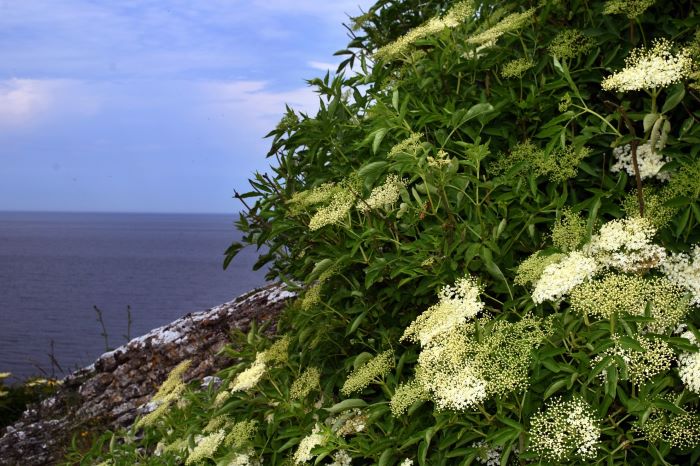
The elder tree refers to various species within the genus Sambucus. Some of the most well-known types of elder trees include:
- European Elder (Sambucus nigra). This is one of the most common elder species. It produces clusters of small, creamy-white flowers.
- American Elder (Sambucus canadensis). Found in North America, the American elder, also known as the common elderberry, produces similar clusters of creamy-white flowers and dark purple-black berries.
- Red Elder (Sambucus racemosa). This species is native to North America and Europe. It produces red berries and is sometimes referred to as the European red elderberry.
- Blue Elder (Sambucus caerulea). Also known as the blue elderberry, this species is native to North America. It produces clusters of small, bluish-black berries.
Both Europen Elder and American Elder are also referred to a black elder due to their dark-colored berries.
Elderflower a Royal Flavor
Elderflower gained royal attention when it was prominently featured in Prince Harry and Meghan Markle’s wedding cake, elevating its status as a flavor fit for a royal occasion.
The delicate and floral flavor of elderflower has long been used in the culinary world, particularly in Europe where it has been used in traditional drinks, desserts, and syrups. However, its association with royalty has given it a new level of prestige.
The use of elderflower in Meghan Markle’s wedding cake, created by renowned pastry chef Claire Ptak, brought this elegant and aromatic flavor to the forefront of the public’s attention.
Since then, elderflower has become a popular choice for special occasions and celebrations, particularly for wedding cakes and desserts.
What Does Elderflower Taste Like?
Elderflower tastes like a combination of honey, citrus, and lychee. I would also describe the flavor as floral, sweet, and slightly musky. Some people also note a hint of pear in the flavor profile.
Interestingly, the flavor can vary slightly depending on how it is used, but generally, it has a subtle and refreshing taste.
When elderflower is used in drinks such as champagne, cocktails, or elderflower cordial, its flavor shines through and provides a light, aromatic quality.
In cooking, elderflowers add a subtle floral note to dishes like sorbets, jams, and desserts.
Elderflower’s pleasant and sophisticated taste makes it a sought-after ingredient for chefs and mixologists looking to elevate their creations with a touch of floral elegance.
Where To Find Elderflowers
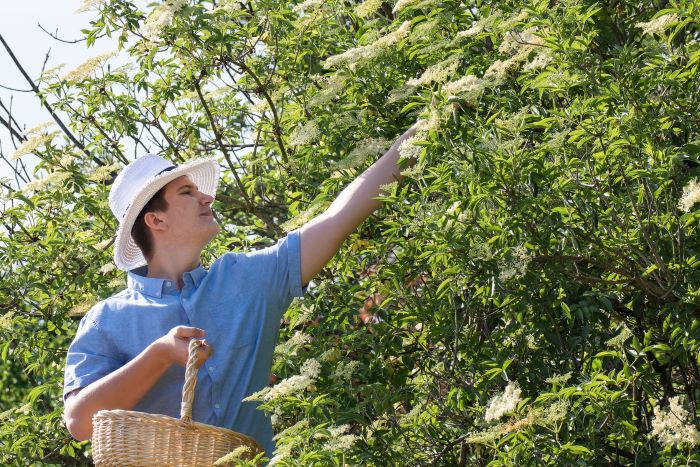
Elderflowers can be found in the wild, but they are also commonly cultivated in gardens and orchards.
In wild locations, look for elderflower bushes in hedgerows, along riverbanks, on the edges of woodlands, and in other wild, uncultivated areas. They are often abundant in Europe and North America.
Many people grow elderflower bushes in their gardens, so you may be able to find them in residential areas, public parks, and botanical gardens.
Some commercial growers cultivate elderflowers for use in products like elderflower syrup and elderflower cordial. So you might find elderflower bushes in orchards and agricultural areas.
If you’re unable to find elderflowers in the wild or in public areas, you might still be able to purchase them at farmers’ markets or specialty stores that sell foraged or locally grown produce.
How to Forage for Elderflowers
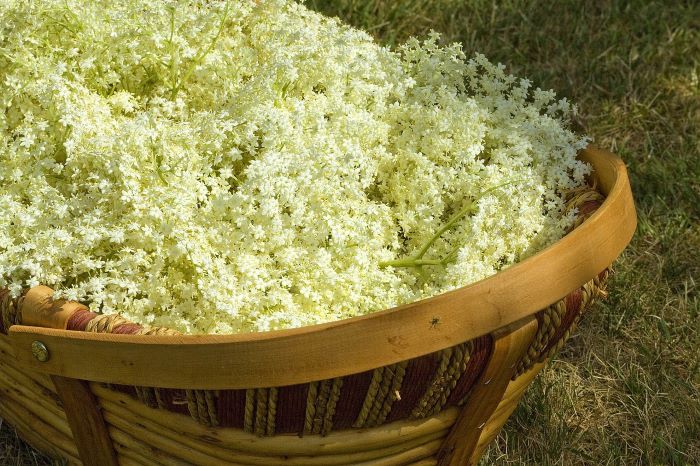
Elderflowers bloom in late spring to early summer and can be foraged for culinary use.
Make sure to correctly identify the elderflower. Elderflowers are small, cream-colored flowers that grow in clusters. The flowers have a sweet, floral scent and are often found in large, flat-topped clusters.
Select flowers that are fully open and have a strong scent. Avoid flowers that are brown or wilting, as these are not suitable for eating.
Use a pair of scissors or garden shears to carefully snip the elderflowers from the tree, making sure to leave enough stem on the flower cluster. Only pick what you need, leaving some flowers behind for the plant to continue to bloom and develop into elderberries later in the season.
Once you have harvested the elderflowers, gently shake them to remove any insects or dirt. It’s best to avoid washing the flowers, as this can dilute their flavor and fragrance.
If you plan to use the elderflowers immediately, store them in a cool place until you are ready to use them. If you want to preserve them for later use, dry the flowers on a clean, dry cloth for a few hours before storing them in an airtight container.
How to Use Elderflower
Elderflowers can be used to flavor dishes and drinks in many ways. Here are some ideas you can try.
Elderflower Syrup
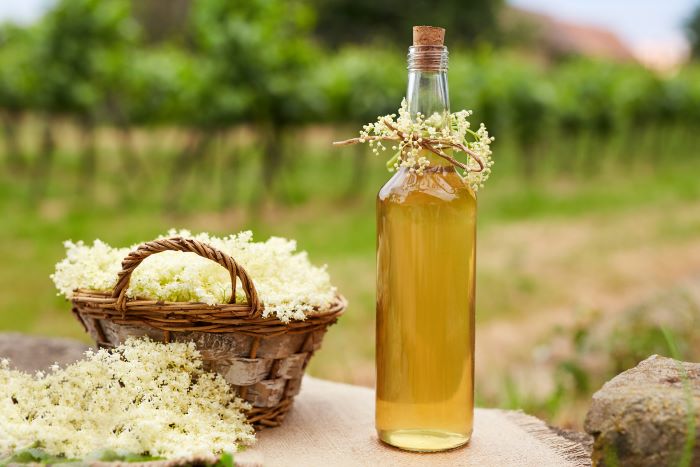
Create a simple syrup by boiling water, sugar, and elderflower heads together. This syrup can be used to sweeten cocktails, drizzle over desserts, or to flavor beverages.
To make elderflower syrup, you will need:
- 2 cups water
- 2 cups granulated sugar
- 10-12 fresh elderflower heads, stems trimmed
Method:
- In a saucepan, combine the water and sugar. Bring the mixture to a boil, stirring occasionally to dissolve the sugar.
- Once the sugar has dissolved, add the elderflower heads to the saucepan. Reduce the heat to low and let the mixture simmer for 10-15 minutes.
- Remove the saucepan from the heat and let the syrup cool to room temperature.
- Strain the syrup through a fine mesh sieve or cheesecloth to remove the elderflower heads and any impurities.
- Transfer the elderflower syrup to a clean, airtight container and store it in the refrigerator for up to 2 weeks.
Once you have your elderflower syrup, you can use it to sweeten cocktails such as a Elderflower Collins or a Hugo spritz, drizzle it over desserts like pancakes or ice cream, or even mix it with sparkling water for a refreshing elderflower soda. Enjoy!
Infuse Spirits
Add elderflower blossoms to gin, vodka, or other spirits to create a fragrant and floral infusion. This can be used in cocktails or enjoyed on its own.
Here’s how to infuse spirits with elderflower:
- Gather your elderflower blossoms and the spirit of your choice (gin, vodka, etc.)
- Choose a clean, airtight container to infuse the spirits. A glass jar works well for this purpose.
- Place the elderflower blossoms in the container. You can use as much or as little as you like, depending on how strong you want the flavor to be. A good starting point is to use about 1 cup of elderflower blossoms for every 750ml bottle of spirit.
- Pour the spirit over the elderflower blossoms in the container.
- Seal the container tightly and let the infusion sit for at least 24 hours. You can taste it along the way to see if it has reached your desired level of flavor.
- Once the infusion is ready, strain out the elderflower blossoms and transfer the infused spirit back into its original bottle or another airtight container.
- Enjoy the fragrant and floral elderflower-infused spirits in cocktails or simply on the rocks.
Make sure to store the infused spirits in a cool, dark place to maintain their flavor and freshness. Always use fresh elderflower blossoms for the best flavor.
Bake with Elderflower
You can add elderflower to cake batters, cookies, or other baked goods to infuse them with a delicate floral flavor. Here are a few example ideas.
For an Elderflower Lemon Drizzle Cake, you can add elderflower cordial to the cake batter and mix in some lemon zest for a refreshing and fragrant twist on a classic lemon drizzle cake.
To make Elderflower and Blueberry Muffins, fold some elderflower syrup into the muffin batter and add a handful of fresh blueberries for a deliciously floral and fruity treat.
Elevate your shortbread with Elderflower Shortbread Cookies by adding a few tablespoons of elderflower liqueur to your favorite shortbread cookie recipe for a sophisticated and unique flavor.
For Elderflower and White Chocolate Cupcakes, infuse the cupcake batter with elderflower essence and top with a white chocolate frosting for a decadent and elegant dessert.
To make a delicious Elderflower and Raspberry Swirl Cheesecake, swirl some elderflower syrup into a creamy cheesecake batter and add a raspberry compote for a beautiful and delicious dessert.
Use elderflower in moderation as it has a delicate flavor.
Elderflower Tea
Elderflower tea is known for its subtle floral flavor with a hint of sweetness.
It can be used to help alleviate cold and flu symptoms, as well as to promote relaxation and reduce stress.
The elderflower is also believed to have anti-inflammatory and antioxidant properties, making it a popular choice for a natural remedy.
To make elderflower tea, simply steep a handful of elderflower blossoms in hot water for 5-10 minutes, depending on your desired strength. You can add honey or lemon for extra flavor, or even mix it with other herbal teas for a unique blend.
Mix Elderflower into Cocktails
Elderflower liqueur can be used to add a bright and floral note to cocktails like the classic elderflower martini or the popular elderflower spritz. Here are a few cocktail ideas that incorporate elderflower.
Elderflower Martini
- 2 oz vodka
- 1 oz elderflower liqueur
- 1/2 oz fresh lime juice
- Ice
- Lime twist for garnish
In a shaker, combine vodka, elderflower liqueur, and lime juice. Add ice and shake well. Strain into a chilled martini glass and garnish with a lime twist.
Elderflower Spritz
- 2 oz elderflower liqueur
- 3 oz prosecco
- Splash of soda water
- Fresh mint leaves
- Ice
- Lemon twist for garnish
Fill a glass with ice, then pour in the elderflower liqueur and prosecco. Top with a splash of soda water and stir gently. Garnish with fresh mint leaves and a lemon twist.
Elderflower Gin Fizz
- 1 1/2 oz gin
- 1/2 oz elderflower liqueur
- 1/2 oz fresh lemon juice
- 1/4 oz simple syrup
- 1 egg white
- Ice
- Club soda
- Lemon twist for garnish
In a shaker, combine gin, elderflower liqueur, lemon juice, simple syrup, and egg white. Shake vigorously without ice. Add ice to the shaker and shake again. Strain into a glass filled with ice, then top with club soda. Garnish with a lemon twist.
Elderflower Desserts with Recipe Ideas
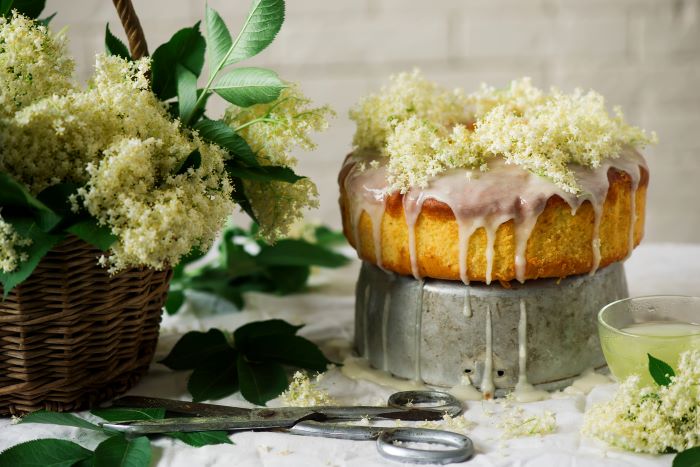
You can use elderflower to flavor fruit salads, sorbets, puddings, or other desserts for a unique and refreshing taste. Here are some delicious dessert ideas with recipes to try.
Elderflower and berry trifle – Layer ripe mixed berries with elderflower-scented whipped cream and ladyfinger biscuits for a light, summery dessert.
Try one of these elderberry trifle recipes:
Elderflower panna cotta – Infuse cream with elderflower, then set it with gelatin to create a delicate and floral panna cotta. Serve with a drizzle of elderflower syrup and fresh berries.
Here are a few elderberry panna cotta recipes:
Elderflower and lemon sorbet – Combine elderflower syrup with freshly squeezed lemon juice and freeze into a refreshing sorbet. Serve with a sprig of fresh mint for a beautiful finish.
Check out this delicious elderflower and lemon sorbet recipe:
Elderflower and peach tart – Arrange thinly sliced peaches on a buttery pastry crust, then glaze with elderflower syrup for a sweet and fragrant dessert.
Find elderflower tart recipe inspiration:
Elderflower and vanilla poached fruit – Simmer ripe fruit such as pears or apricots in a mixture of elderflower syrup and vanilla bean for a simple yet elegant dessert.
Elderflower pavlova – Fold elderflower syrup into whipped cream and spoon onto a light and crispy meringue base. Top with fresh berries and a sprinkle of edible flowers for a stunning dessert.
Elderflower and prosecco jelly – Mix elderflower syrup with sparkling wine and gelatin, then set in individual molds for a fun and fizzy dessert.
Elderflower and coconut rice pudding – Infuse coconut milk with elderflower and simmer with arborio rice until creamy. Serve warm or chilled with a sprinkle of toasted coconut on top.
Elderflower and almond cake – Add elderflower syrup to a classic almond cake batter for a subtle floral twist. Top with a simple elderflower glaze for a beautiful finishing touch.
Check out this recipe:
Elderflower and honey yogurt parfait – Layer honey-sweetened Greek yogurt with elderflower-infused granola and fresh fruit for a light and refreshing dessert.
Other Ways to Use Elderflowers
As well as using elderflower in drinks and recipes, elderflowers can also be used for pampering, beauty and to keep your home smelling nice.
Elderflower Bath Soak
Because elderflowers are known for their calming and soothing properties, they make the perfect addition to a bath soak. The gentle floral scent can help to ease stress and tension, while the dried flowers themselves can help to soften and nourish the skin.
To create an elderflower bath soak, simply gather a handful of dried elderflowers and place them in a muslin bag or a clean sock. Tie the bag securely and then toss it into a warm bath as it fills. Allow the elderflowers to steep in the water for a few minutes before getting in.
Once in the bath, you can also gently squeeze the bag to release more of the fragrant oils and botanical goodness into the water.
Soak in the bath for at least 20 minutes to fully experience the benefits of the elderflower bath soak.
Elderflower Perfume
To make the elderflower perfume, start by picking fresh elderflowers. Make sure they are free from any bugs or debris and are at their peak fragrance.
Next, place the elderflowers in a clean glass jar and cover them with a carrier oil of your choice, such as sweet almond oil or jojoba oil. Make sure the flowers are completely submerged in the oil.
Seal the jar and allow the elderflowers to infuse their scent into the oil for 1-2 weeks. Shake the jar gently every day to help release the fragrance.
After the infusion period, strain the oil through a fine mesh sieve or cheesecloth into a clean glass bottle. Discard the elderflowers.
Your natural elderflower perfume is now ready to use. Simply apply a small amount to your pulse points for a subtle, floral scent. You can also customize the scent by adding a few drops of essential oils such as jasmine or rose for a more complex fragrance.
Store the perfume in a cool, dark place to preserve its freshness.
Elderflower Hair Rinse
Known for its soothing and nourishing properties, elderflowers make a great natural ingredient to use on your hair. Use this elderflower hair rinse once or twice a week to keep your hair looking and smelling beautiful. Here’s how to make an elderflower hair rinse:
- Gather elderflowers from a clean and pesticide-free area. You will need about 1-2 cups of elderflowers for the rinse.
- Boil 2-3 cups of water in a pot and add the elderflowers to the water once it reaches a rolling boil.
- Allow the elderflowers to steep in the hot water for about 20-30 minutes. This will infuse the water with the essence and beneficial properties of the elderflowers.
- Strain the elderflowers from the water and allow the mixture to cool completely.
- Once the elderflower infusion is cooled, use it as a final rinse after shampooing and conditioning your hair. Pour the elderflower rinse over your hair, making sure to saturate the strands thoroughly.
- Gently massage the elderflower rinse into your scalp and hair, and then allow it to sit for a few minutes before rinsing it out with cool water.
- Style your hair as usual, and enjoy the added shine and subtle floral scent that the elderflower rinse provides.
Elderflower Sachets
Fill small cloth bags with dried elderflowers and place them in your drawers or closets to add a pleasant scent to your clothes.
You can also place the sachets in your car or in any area that could use a little freshening up. The delicate floral scent of elderflowers will leave your belongings smelling lovely and natural.
You can even give these sachets as gifts to friends and family, as they make a unique and thoughtful present. Just make sure to replace the elderflowers every few months to keep the scent fresh and potent.
Elderflower Skincare
Known for its skin-soothing and anti-inflammatory properties, elderflowers make an excellent ingredient for skincare products such as infused oil, balm, lotions and serums.
To create elderflower-infused oil, simply steep dried elderflowers in a carrier oil such as jojoba, almond, or olive oil for a few weeks. Once the oil is infused, you can use it as a base for various homemade skincare products.
For a soothing elderflower balm, mix the elderflower-infused oil with beeswax and a few drops of essential oils like lavender or chamomile. This balm can be used to moisturize dry skin or soothe irritation.
To create an elderflower lotion, combine the elderflower-infused oil with shea butter, aloe vera gel, and a natural emulsifying wax. This lotion can help hydrate and soften the skin, making it perfect for everyday use.
If you prefer a facial serum, mix the elderflower-infused oil with nourishing oils like rosehip seed oil, argan oil, and vitamin E oil. This serum can provide deep hydration and promote a healthy, glowing complexion.
By using elderflower-infused oil in your homemade skincare products, you can harness the natural benefits of elderflower for healthy, radiant skin. Plus, you have the added satisfaction of creating your own natural skincare products at home.
Related reading:
- Eating Purslane the Edible Weed (with Recipe Ideas)
- What Are Rose Hips And How To Eat Them
- Eating Hops And Uses Beyond Beer
- Kaffir Lime Fruit Uses In The Kitchen And Home
- Eating Nasturtium – Tips for Using Nasturtium In The Kitchen
- Tips For Eating Dandelion Greens, Flowers, and Roots
- Eating Warrigal Greens: Cooking and Recipes Ideas
